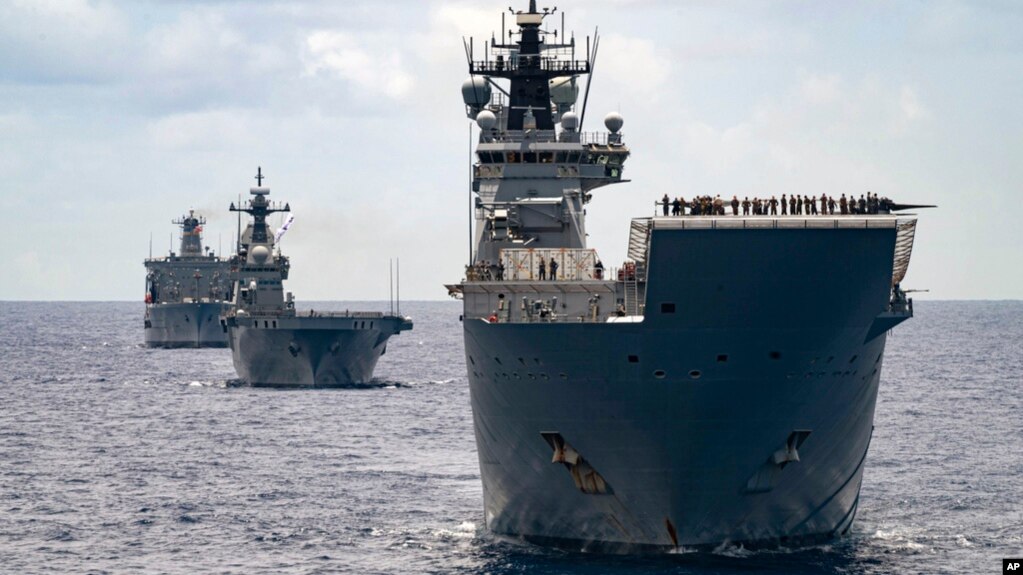World’s largest naval exercise sends message to China

FILE – Royal Australian Navy ships sail in formation with 37 others during the Rim of the Pacific exercises in 2022. The 2024 version is underway now, with 29 nations participating. (Australian Defense Force)
The United States and 28 partner nations have begun the world’s largest naval war exercise off the shores of Hawaii, known as the Rim of the Pacific, or RIMPAC.
This year’s exercise brings international cooperation on a scale like no other: 40 surface ships, more than 150 aircraft, three submarines and 25,000 people.
Nations from around the globe are practicing a wide range of missions, from natural disaster response to attack skills needed for war. While most participants are nations with Pacific coastlines, this year’s RIMPAC also includes non-Pacific nations, including the United Kingdom, France, Brazil and Israel.
“Every nation in the world that has interests in the Pacific and will adhere to the same values is more than welcome to participate,” said Chilean Navy Commodore Alberto Guerrero, RIMPAC deputy commander.

One country not invited? China.
Why? Because the warm welcome RIMPAC gave to China in 2014 and 2016 backfired, according to Markus Garlauskas, director of the Indo-Pacific Security Initiative at the Atlantic Council.
“There was this outreach to China, and definitely the U.S. and its allies and partners were essentially burned by the Chinese taking advantage of it … as an opportunity to essentially collect intelligence and to try and get more acceptance of what should be considered unacceptable behavior,” Garlauskas told VOA.
Since China’s last RIMPAC in 2016, he said, Beijing ramped up its aggressive behavior, building and militarizing more artificial islands in international waters, conducting aggressive maneuvers around Taiwan in recent months and pummeling Philippine ships with water cannons in recent days.
But the biennial exercise, officials say, can send a strong message to China to stop bullying its neighbors. RIMPAC nations this year will practice targeting the decommissioned assault ship USS Tarawa, in a rare chance to learn how effective their weapons are at sinking a large and protected adversary in open waters.
“They’re not just going to be facing the United States in the country they’re targeting, but they’re potentially going to have to deal with a response from a wide range of countries that have common interests in deterring and confronting Chinese aggression as threats to a free and open Indo-Pacific,” Garlauskas said.
Israel’s inclusion this year sparked calls from pro-Palestinian activists wanting countries to skip the exercise in protest. Malaysia’s prime minister addressed the protesters ahead of the exercises, saying that while his country would continue to speak out in support of the Palestinian people, Malaysia needed to act in a way that was “not driven by anger,” while also considering the practical implications of missing the major military exercise.
RIMPAC is set to end in early August.
News
The Hanging Temple: China’s 1,500-Year-Old Cliffside Marvel of Faith and Engineering
The Hanging Temple: China’s 1,500-Year-Old Cliffside Marvel of Faith and Engineering Perched precariously on the cliffs of Mount Heng in Shanxi Province, China, the Hanging Temple, also known as Xuankong Temple, Hengshan Hanging Temple, or Hanging Monastery, is an architectural…
The Willendorf Venus: A 30,000-Year-Old Masterpiece Reveals Astonishing Secrets
The Willendorf Venus: A 30,000-Year-Old Masterpiece Reveals Astonishing Secrets The “Willendorf Venus” stands as one of the most revered archaeological treasures from the Upper Paleolithic era. Discovered in 1908 by scientist Johann Veran near Willendorf, Austria, this small yet profound…
Unveiling the Maya: Hallucinogens and Rituals Beneath the Yucatán Ball Courts
Unveiling the Maya: Hallucinogens and Rituals Beneath the Yucatán Ball Courts New archaeological research has uncovered intriguing insights into the ritual practices of the ancient Maya civilization. The focus of this study is a ceremonial offering found beneath the sediment…
Uncovering the Oldest Agricultural Machine: The Threshing Sledge’s Neolithic Origins
Uncovering the Oldest Agricultural Machine: The Threshing Sledge’s Neolithic Origins The history of agricultural innovation is a fascinating journey that spans thousands of years, and one of the earliest known agricultural machines is the threshing sledge. Recently, a groundbreaking study…
Nara’s Ancient Sword: A 1,600-Year-Old Protector Against Evil Spirits
Nara’s Ancient Sword: A 1,600-Year-Old Protector Against Evil Spirits In a remarkable discovery that has captured the attention of archaeologists and historians alike, a 7.5-foot-long iron sword was unearthed from a 1,600-year-old burial mound in Nara, Japan. This oversized weapon,…
The Inflatable Plane, Dropped Behind the Lines for Downed Pilots
Experimental The Inflatable Plane, Dropped Behind the Lines for Downed Pilots The Inflatoplane from Goodyear was an unconventional aircraft developed by the Goodyear Aircraft Company, a branch of the renowned Goodyear Tire and Rubber Company, also famed for the Goodyear…
End of content
No more pages to load











